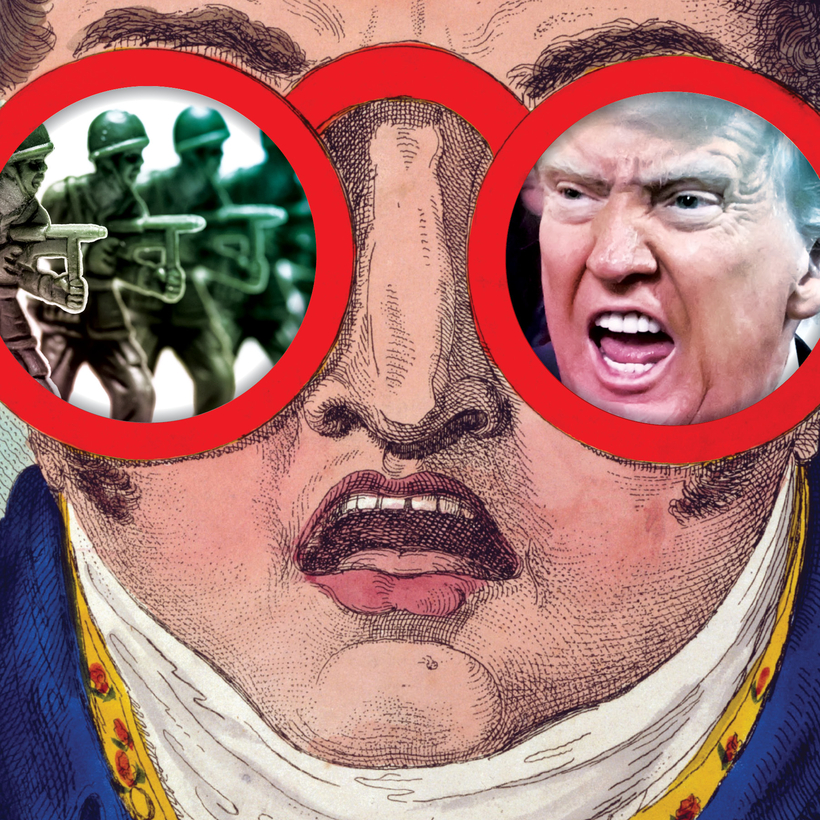Imagine National Guard soldiers from the Republican states of Texas, Florida, and Arkansas arriving in the Democratic sanctuary cities of Los Angeles, New York, and Philadelphia, suppressing protests, rounding up immigrants, and jailing anyone who gets in their way. This Civil War–like scenario is one step the Trump administration might take, as it attempts to turn the National Guard into an anti-immigrant army answerable only to the president.
Much of the media scrutiny this past week has focused on whether Trump intends to invoke the Insurrection Act, the sweeping authority that allows the president to use the military wherever, and however he wants, in order to protect the country from domestic threats.
So far, Trump has not invoked it, just as he didn’t in 2020 during the George Floyd protests. At that time, it was the attorney general, Bill Barr, and General Mark Milley, the chairman of the Joint Chiefs of Staff, who persuaded him not to use it—with the latter reportedly “recoiling at the idea.” The act has not been invoked since 1992, during the Los Angeles riots, when dozens of people were killed and hundreds of businesses were looted and burned to the ground. It is generally seen as a “last resort” that even Trump has shied away from.
But what if Trump has found a loophole that would allow him to use troops however he wants, and send them wherever he likes, without invoking the Insurrection Act?
The National Guard comprises 54 units, one from each state and territory. Its force consists of 430,000 largely part-time and some full-time members. It’s larger than the U.S. Navy, U.S. Air Force, and Marines, and it makes up some 40 percent of the modern U.S. Army’s overall operating force. It can call on M1 Abrams tanks, M109 howitzers, and more than 1,000 aircraft, including F-35s and B-2 stealth bombers.
From its earliest days, it has been utilized within the United States to crush rebellions, head off slave revolts, suppress (and shoot) rioters, and break up strikes, particularly those enacted by immigrant laborers. Yet post-9/11, it has increasingly become a reserve force for the army, supporting military operations in Afghanistan and Iraq. And it’s this blurring of purpose that has left it open to the current administration’s whims.
What makes the National Guard peculiar is how it’s controlled. Each guard unit is subject to its state’s governor, but on occasion—usually during an emergency—the force can be “federalized” and placed under the control of the president. This is what Trump did when he federalized 4,000 members of the California National Guard and sent them to Los Angeles.
Typically, the president gets a request from the governor of a state to do this. While it was unusual for Trump to bypass Gavin Newsom, the Democratic governor of California, it was not unheard of. Lyndon Johnson federalized the National Guard against the governor of Alabama’s wishes in 1965. (Admittedly, Johnson did so to protect civil-rights advocates marching in Selma, while Trump’s deployment was, ostensibly, to protect U.S. Immigration and Customs Enforcement agents.)
Trump claimed his right to do this under Title 10 of the U.S. Code—the compilation of permanent laws enacted by Congress—which allows the president to take control of a state’s National Guard if “there is a rebellion, or danger of a rebellion against the authority of the United States.” In this particular case, it was the demonstrations against raids made by ICE (which is part of the Department of Homeland Security) that gave him the excuse to do so.
However, all federal troops—which the California National Guard are now considered to be—are subject to the Posse Comitatus Act. This law decrees that, in general, members of the federal military are not allowed to participate in civilian law enforcement. They can’t arrest individuals, or search homes, or enforce the local laws. And so far, they haven’t done any of those things in California.
At the time of writing, the Posse Comitatus Act is holding Trump in check. But what if he finds a way to free National Guard units from this constraint? Title 32 of the U.S. Code offers just such a loophole, which, some government insiders believe, Trump may be considering.
Title 32 allows National Guard units to perform missions set by the president, even if, legally speaking, they are still under state control. The Guard would then operate in what Elizabeth Goitein, senior director at the Brennan Center for Justice, a law-and-policy organization, has termed a “hybrid status.” It would allow the president to order National Guard units to take part in domestic law-enforcement activities without having to be federalized and, therefore, not beholden to the Posse Comitatus Act.
Trump already tested Title 32 out when, in 2020, he asked governors to deploy National Guard units to Washington, D.C., to help quell civil unrest. Some refused, notably the Democratic governors of New York, Virginia, and Delaware. However, the Republican governors of Tennessee, Utah, and South Carolina all sent troops.
And this is all Trump needs. If a few friendly red-state governors, such as Texas’s Greg Abbott or Louisiana’s Jeff Landry, were to go along with such a request, then thousands of Texas and Louisiana National Guardsmen would be under the direct control of the president. They could then be ordered to enter blue-state sanctuary cities—a catchall term that generally refers to areas that refuse to comply with requests from ICE officers—to fight protesters and round up immigrants.
The possibility already has many worried. Washington State was so concerned about Title 32 being used to send National Guard troops across its borders from red states that on April 21 it passed a law—“concerning the governor’s authority to limit outside militia activities within the state”—expressly forbidding it.
This worry has been exacerbated by the fact that National Guard soldiers have already been deputized by immigration authorities and given powers of arrest. In February, the Texas National Guard was granted the authority to make immigration arrests and detain and deport undocumented people within Texas, following an agreement with the Trump administration—the first time National Guard troops have been asked to assist at this level in deportations. Florida followed soon after.
Some legal scholars believe that any attempt to send troops into another state through Title 32 would be legally questionable at best. While Goitein sees the current use of National Guard troops in Los Angeles as “an egregious abuse of power,” sending a state’s National Guard “into another state without consent or permission seems blatantly unconstitutional.” However, she says that any lawsuit that attempted to stop such a violation of states’ sovereignty “wouldn’t be instantaneous” and could play out over weeks.
Sarah Mehta, a deputy director of government affairs at the A.C.L.U., has been following the militarization of governmental immigration forces for months. The sending of troops across state lines “is one of the murkiest areas, and we’ve just never seen it tested.... I hope it will remain untested.” But, she says, extraordinary measures are already taking place, pointing to a recent Department of Homeland Security memo requesting 20,000 National Guard troops to, among other things, transport “unaccompanied alien children” across state lines.
Professor William C. Banks, the founding director of the Institute for National Security and Counterterrorism, believes that “all hell would break loose” if red-state National Guard troops moved into blue states. He believes that Trump has yet to enforce the Insurrection Act because “when there’s a pervasive presence of the military on the streets, we the people don’t like it very much,” but acknowledges that this administration’s incessant testing of laws—whether through Title 10 or Title 32—may well be a calculated prelude to his pulling the trigger.
Certainly, the exploitation of such legal loopholes has been the calling card of the Trump administration. Indeed, it has already stretched the law governing the military’s role in law enforcement to absurd lengths at the southern border.
In April, Defense Secretary Pete Hegseth declared that almost 260 miles of the border were “extensions” of existing U.S. Army bases and thus “National Defense Areas.” Whereas before, troops could act only in support of the U.S. Border Patrol, now, any immigrants who wander into these areas—which are not demarcated—could be searched and held as trespassers. The army has traditionally not been allowed to hold people captive on U.S. soil, and courts in New Mexico and Texas have begun to push back, dismissing charges in some cases. But the broader trend is unmistakable: the militarization of domestic enforcement through administrative fiat, and the steady erosion of the civilian-military boundary.
One of the effects of the Trump administration’s brazenness is that warning signs are sometimes overlooked. On April 28, Trump signed three executive orders. The one that caught the eye of the press stated that truck drivers had to learn English. But another, entitled “Strengthening and Unleashing America’s Law Enforcement to Pursue Criminals and Protect Innocent Citizens,” laid out exactly what is happening now:
“Within 90 days of the date of this order, the Attorney General and the Secretary of Defense, in consultation with the Secretary of Homeland Security and the heads of agencies as appropriate, shall increase the provision of excess military and national security assets in local jurisdictions to assist State and local law enforcement.” It also stated that it should be determined how “military and national security assets” can be “utilized to prevent crime.” The National Guard was deployed in Los Angeles just 41 days later.
Whether the Title 32 gambit is deemed constitutional is ultimately unimportant. Trump has never waited for consensus, only for an opening. The lawsuits and constitutional challenges will come, but by then the National Guard may already be on the ground. It doesn’t require a national emergency to trigger this move. It requires only a compliant legal framework, a handful of willing governors, and a president unconcerned with precedent.
George Pendle is a Deputy Editor at AIR MAIL


